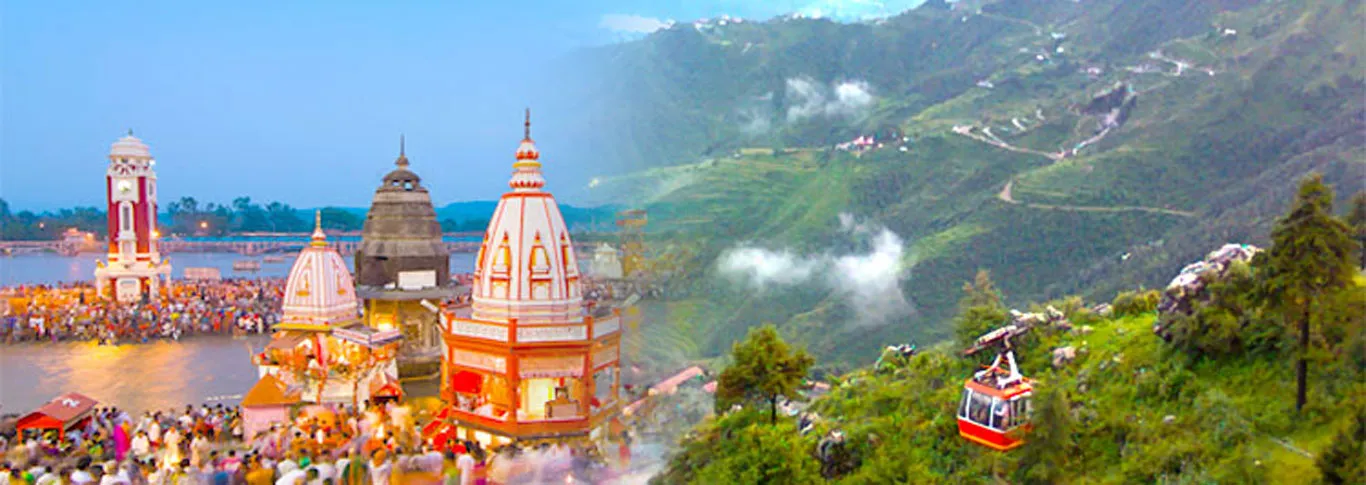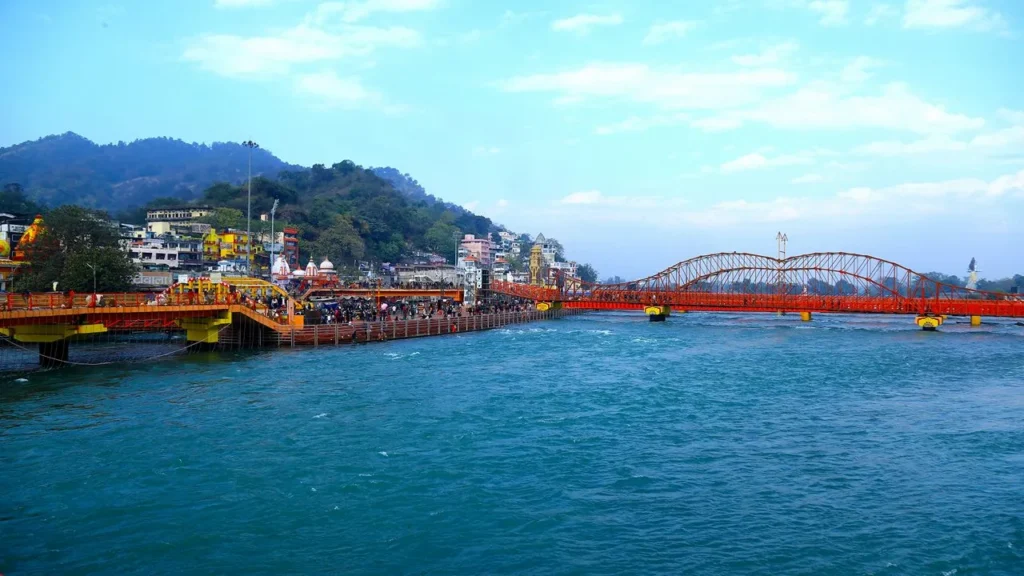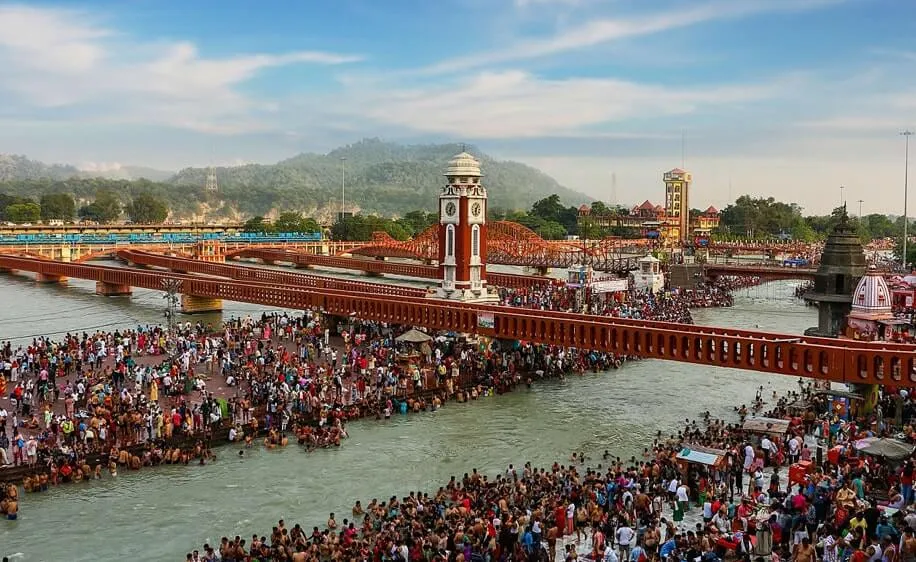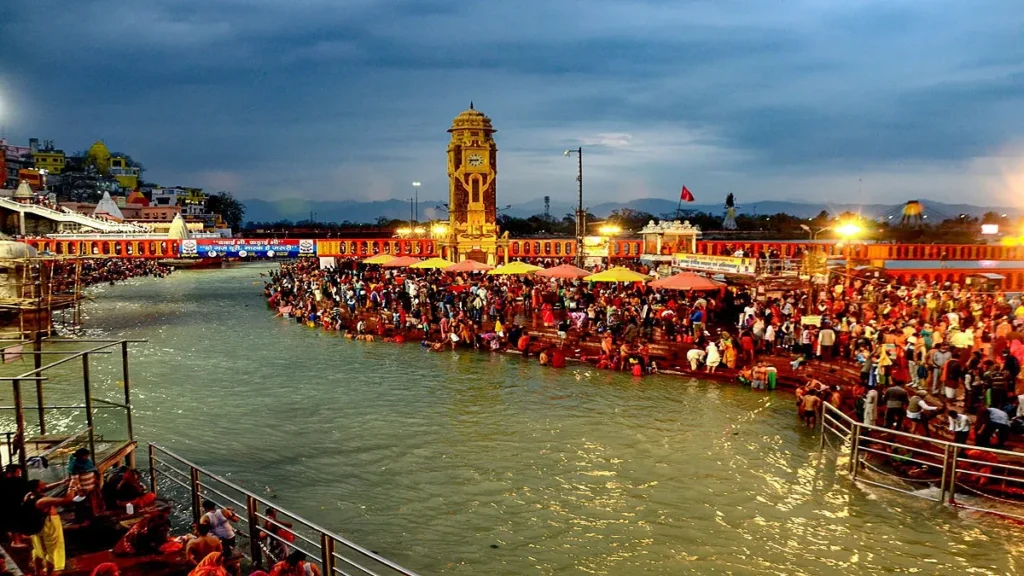Urbania Rentals India | Affordable Urbania Rentals for Outstation & Local Trips
Haridwar Travel Guide

Haridwar Travel Guide - Explore the Sacred Town of Haridwar During Char Dham Yatra
Located at the foothills of the Himalayas, Haridwar is a city of temples and ashrams One of the holiest pilgrimages in India, Haridwar, the ‘gateway to gods’, is located where the holy river Ganga enters the Indo-Gangetic plains. The holy river Ganga enters the Indo-Gangetic Plains of North India for the first time in Haridwar. Thereby making its former name ‘Gangadwara‘ perfect in every sense. Take a bath in the holy Ganges. According to Hindu mythology, doing this removes all your sins and you will be able to achieve salvation. On an average, one billion people take a dip in the river every year and the number increases to 10 billion during the Kumbh Mela.
Haridwar is one of the four holy Indian cities that host the Kumbh Mela, a pious gathering of millions of Hindu devotees every 12 years. The Ardh Kumbh is organised here every six years. It also hosts the Kanwar mela every year during the rainy season. The ‘Panch Tirth’ or the five pilgrimages located within the periphery of Haridwar, are Gangadwar (Har Ki Pauri), Kushwart (Ghat), Kankhal, Bilwa Tirtha (Mansa Devi Temple) and Neel Parvat (Chandi Devi). Haridwar serves as the gateway to the Char Dham of Uttarakhand as well. Every morning and evening, the ghats (stepped banks of a river) of River Ganga witnesses the blissful Ganga aarti, which attracts devotees and tourists from within the country and around the world. It is a spectacular sight as thousands of small diyas (earthen lamps) are set afloat on the river. Photographers from all over the world come to capture the grand ceremony as well.
If you want to know more and experience the ancient methods of healing, there are many certified Ayurvedic clinics in Haridwar that you can visit. Ashrams also offer sessions in Ayurveda, meditation and yoga. Some of the ashrams are Shantikunj, Ma Anandamayi Ashram, Sapt Rishi Ashram, Harihar Ashram, Bharat Sevashram Sangha and Vyas Ashram.Being an ancient city with its roots steeped in culture and traditions of the Vedic times, Haridwar is popular for Ayurvedic practitioners and institutions. Visit a certified Ayurvedic clinic or enjoy a traditional massage at one of the nearby spas.
Spiritual Significance and Mythological Background
Haridwar’s spiritual importance is deeply rooted in Hindu mythology. It is one of the four sites where drops of Amrit (the elixir of immortality) fell during the Samudra Manthan (the churning of the ocean). The city is considered one of the seven holiest places in India.

Ganga's Descent
According to mythology, King Bhagirath performed severe penance to bring the Ganges from heaven to earth to liberate his ancestors. Haridwar is where the river first enters the plains. The story of Bhagirath’s efforts to bring the Ganges to Earth is a central theme in Hindu mythology, highlighting themes of determination and divine grace. The Puranas detail Bhagirath’s intense penance and Lord Shiva’s role in controlling the river’s descent.

Samudra Manthan
The churning of the cosmic ocean (Samudra Manthan) is a central epic in Hindu cosmology. The gods (Devas) and demons (Asuras) churned the ocean using Mount Mandara as the churning rod and Vasuki, the serpent, as the rope. This process yielded many divine treasures, including Amrit.

Kumbh Mela
Haridwar is one of the four cities that host the Kumbh Mela, a massive gathering of devotees that occurs every 12 years. The Ardh Kumbh Mela is held here every six years. This event is one of the largest peaceful gatherings in the world, attracting millions of pilgrims who come to bathe in the Ganges. The Kumbh Mela is a significant display of faith and cultural tradition. The exact date of the Kumbh Mela is determined by astrological calculations based on the positions of Jupiter and the Sun.
Panch Tirth
Haridwar encompasses the ‘Panch Tirth’, or the five pilgrimages, which are:
Gangadwar (Har Ki Pauri)
Kushwart (Ghat)
Kankhal
Bilwa Tirtha (Mansa Devi Temple)
Neel Parvat (Chandi Devi)
These sites hold immense religious importance for devotees.
Gangadwar (Har Ki Pauri)
The most important of the five, marking the spot where Ganga enters the plains.
Kushawart Ghat
A sacred ghat where pilgrims often perform rituals for their ancestors.
Kankhal
An ancient part of Haridwar with significant temples and ashrams.
Bilwa Tirtha (Mansa Devi Temple)
The temple dedicated to Goddess Mansa Devi.
Neel Parvat (Chandi Devi Temple)
The hilltop temple dedicated to Goddess Chandi.
A Glimpse into History
Haridwar’s history dates back to ancient times. It has been mentioned in various Hindu scriptures and was also visited by foreign travelers like Megasthenes and Hiuen Tsang.
Ancient Mentions
The city was originally known as Gangadwára, and its significance as a pilgrimage site has been documented for centuries. The name ‘Gangadwara’ reflects its position as the gateway where the Ganges enters the plains.
Medieval Period
Haridwar continued to be an important center for religious and cultural activities. Various rulers and dynasties influenced the region, contributing to its rich cultural heritage.
British Influence
During the British colonial era, Haridwar saw some development in terms of infrastructure, including the construction of the Ganges Canal. The Ganges Canal, built by the British, is a major feat of engineering and continues to be vital for irrigation.
Historical Mentions
The city has been mentioned in several Hindu texts, scriptures, and books from the time of Buddha to the British period. Ancient explorers like Megasthenes and Hiuen Tsang have also documented their visits to Haridwar. The region was ruled by the Maurya Empire (322-185 BCE) and the Kushan Empire (c. 1st-3rd centuries).
Megasthenes: The Greek ambassador to the court of Chandragupta Maurya, who mentioned “the holy springs” in his writings, likely referring to Haridwar.
Hiuen Tsang: The Chinese Buddhist monk who visited India during the 7th century CE and described Haridwar as “Mo-yu-lo,” noting its religious significance.
Ganges Canal
Construction began in 1842 and was completed in 1854. It is considered one of the earliest and most significant irrigation works of the British period in India.
The Soul-Stirring Ganga Aarti
One of the most captivating experiences in Haridwar is witnessing the Ganga Aarti at Har Ki Pauri. This mesmerizing ritual is performed daily at sunset, and it’s a deeply spiritual experience.
Har Ki Pauri
The main ghat in Haridwar, believed to be the spot where the Ganges enters the plains. Har Ki Pauri is considered the most sacred ghat in Haridwar and is always bustling with pilgrims and tourists who come to take a dip in the holy Ganges. The ghat is also known as Brahma Kund, and it is believed that a drop of Amrit fell here during the Samudra Manthan.
Brahma Kund
The specific area within Har Ki Pauri where the Amrit is believed to have fallen. It is considered the most sacred spot within the ghat.
The Ceremony
Priests perform the aarti with lamps, chanting hymns, and devotees offer flowers and diyas to the river. The atmosphere is filled with devotion and a sense of divine energy. The Ganga Aarti is a spectacular sight, with thousands of small diyas (earthen lamps) set afloat on the river, creating a magical and divine ambiance.
Ritual elements: The aarti involves the waving of multi-tiered lamps (diyas) in a synchronized manner, accompanied by the chanting of mantras and the ringing of bells. The smoke from the lamps is considered purifying.
Devotional participation: Devotees offer flowers (pushpa) and small lamps (diyas) to the river as part of the ceremony, symbolizing their reverence for the Ganges.
Must-Visit Temples in Haridwar
Haridwar is home to numerous temples, each with its own unique significance. Here are some of the most important ones:
Mansa Devi Temple
Located on Bilwa Parvat, this temple is dedicated to Goddess Mansa Devi, who is believed to fulfill the wishes of devotees. A ropeway ride offers stunning views. Mansa Devi Temple is one of the most famous temples in Haridwar, and devotees can be seen tying red threads to the tree within the temple precincts as offerings.
Mansa Devi: The name “Mansa” is derived from the word “Mansa” which means “wish.” The goddess is believed to fulfill the desires of sincere devotees.
Ropeway: The ropeway, known as Mansa Devi Udankhatola, offers panoramic views of Haridwar and the surrounding landscape.
Chandi Devi Temple
Situated atop Neel Parvat, this temple is dedicated to Goddess Chandi. It can be reached by a trek or a ropeway. Chandi Devi Temple is one of the five pilgrimages of Haridwar and is also one of the three Siddha Peethas.
Chandi Devi: Goddess Chandi is a fierce form of Durga. The temple was built by the King of Kashmir, Suchat Singh, in the 20th century, though the main idol is believed to have been installed by Adi Shankaracharya in the 8th century.
Siddha Peetha: A place of worship where desires are believed to be fulfilled.
Maya Devi Temple
An ancient temple dedicated to Goddess Maya Devi, considered one of the Shaktipeethas. This temple is devoted to Goddess Maya Devi and is considered very sacred by devotees.
Maya Devi: Haridwar’s original presiding deity. It is believed that Haridwar derives its other name, Mayapuri, from this temple.
Shaktipeetha: A significant shrine where parts of the body of Goddess Sati are believed to have fallen.
Daksh Mahadev Temple
Located in Kankhal, this temple is dedicated to Lord Shiva and is associated with the legend of Daksha Prajapati. Daksh Mahadev Temple is said to be constructed at the site where King Daksha performed a yagna (a Hindu fire ritual).
Daksha Prajapati: The father of Sati, Lord Shiva’s first wife. The temple is related to the story of Sati’s self-immolation and the subsequent destruction of Daksha’s yagna by Lord Shiva.
Bharat Mata Mandir
A unique temple dedicated to Mother India, showcasing the history and diversity of the nation. This unique temple, dedicated to Mother India, is seven stories high and houses deities, saints, and secular heroes of all Indian faiths, symbolizing the nation’s unity and diversity.
Seven Stories: Each floor of the temple is dedicated to a different theme, including:
- Floors dedicated to Bharat Mata, the nation’s heroes, saints, and various aspects of Indian culture and history.
Other Temples
Sureshwari Devi Temple: This ancient temple is dedicated to Goddess Durga and is located on the outskirts of the city.
Neelkanth Mahadev Temple: Located 32 km from Rishikesh, this sacred temple is dedicated to Lord Shiva and is scenically situated on a hill at a height of 1330 meters.
- Neelkanth: The name Neelkanth refers to Lord Shiva, whose throat turned blue (neel) after consuming the poison (halahala) that emerged during the Samudra Manthan.
Bilkeshwar Mahadev Mandir: This Shiva temple is situated on a hill.
Embrace Wellness: Ayurveda and Yoga
Haridwar is not only a spiritual hub but also a place for holistic healing.
Ayurveda
Several centers and clinics offer traditional Ayurvedic treatments, massages, and therapies. Haridwar, being an ancient city with roots in the culture and traditions of the Vedic times, is popular for Ayurvedic practitioners and institutions.
Ayurvedic Treatments: Common treatments include Panchakarma (detoxification), Abhyanga (oil massage), and Shirodhara (oil therapy for the head)
Yoga
The city’s serene environment is ideal for yoga. Many ashrams and centers provide yoga classes and retreats. Patanjali Yogpeeth, a large institution, is located here.
Patanjali Yogpeeth: Founded by Baba Ramdev, this is one of the largest yoga institutes in India, offering various yoga programs, Ayurvedic treatments, and research facilities.
Ashrams
Ashrams like Shantikunj, Ma Anandamayi Ashram, Sapt Rishi Ashram, Harihar Ashram, and Bharat Sevashram Sangha offer sessions in Ayurveda, meditation, and yoga.
Shantikunj: The headquarters of the Gayatri Pariwar, a spiritual and social reform organization.
Ma Anandamayi Ashram: An ashram associated with the spiritual teacher Ma Anandamayi.
Other Tourist Attractions
Besides temples and spiritual activities, Haridwar offers a variety of other attractions:
Har Ki Pauri: The most sacred ghat, where the Ganga Aarti takes place.
Shanti Kunj: The headquarters of the Gayatri Pariwar, a spiritual and social organization.
Neel Dhara Pakshi Vihar: A bird sanctuary located on the banks of the Ganges. This forested area is a paradise for bird watchers and trekkers and attracts thousands of migratory birds in winter.
Rishikesh: Located nearby, Rishikesh is known for its adventure activities, yoga centers, and the iconic Lakshman Jhula and Ram Jhula. The ancient town of Rishikesh is a major tourist and pilgrimage hub, often referred to as the ‘Yoga Capital of the World’.
- Lakshman Jhula and Ram Jhula: Suspension bridges across the Ganges, significant landmarks in Rishikesh.
Rajaji National Park: A wildlife sanctuary where you can spot elephants, tigers, and various other animals. Rajaji National Park, located at the Himalayan foothills, near Haridwar, Rishikesh, and Dehradun, is known for its scenic beauty and rich biodiversity.
- Flora and Fauna: The park is home to a variety of wildlife, including elephants, tigers, leopards, deer, and numerous bird species.
Sapt Rishi Ashram and Sapt Sarovar: According to legend, the seven sages meditated here, and the Ganga, not wanting to disturb them, split herself into seven streams (Sapt Sarovar) around them.
- Sapt Rishi: The seven sages (Kashyapa, Atri, Vashishtha, Vishvamitra, Jamadagni, Bharadvaja, and Gautama) are highly revered figures in Hindu tradition.
Kankhal: This is an ancient town located near Haridwar that houses many temples and ashrams, including the Daksh Mahadev Temple and the Ma Anandamayee Ashram.
Bhimgoda Tank: It is located near Har Ki Pauri and is associated with scenes from the Hindu epic Mahabharata.
- Bhimgoda: The tank is believed to be the place where Bhima, one of the Pandava brothers, struck his knee (goda) into the ground to draw water from the Ganges.
Dehradun: The hill station is located near Haridwar and is known for its pleasant year-round weather and scenic surroundings.
Haridwar's Role in Char Dham Yatra
Haridwar plays a crucial role in the Char Dham Yatra, the pilgrimage to the four holy shrines in Uttarakhand: Yamunotri, Gangotri, Kedarnath, and Badrinath.
Gateway to Char Dham: Haridwar is often the starting point for the Char Dham Yatra. Pilgrims gather here before heading to the other destinations.
Preparation and Logistics: The city provides essential services and facilities for pilgrims undertaking the yatra. Haridwar acts as a base for pilgrims, offering accommodation, transportation, and other necessary arrangements for the Char Dham pilgrimage
Char Dham Yatra Distance Chart from Haridwar
| Destination | Distance | Time | Route |
|---|---|---|---|
| Haridwar to Yamunotri Via Dehradun | 221 km | 7/8 Hrs | Haridwar – Dehradun – Mussoorie – Nainbagh – Barkot – Jankichatti– Yamunotri |
| Haridwar to Yamunotri Via Rishikesh | 262 kms | 8/9 hrs | Haridwar – Rishikesh – Narendranagar – Chamba – Chinyalisaur – Dharasu Band – Barkot – Jankichatti – Yamunotri |
| Haridwar to Gangotri | 300 kms | 10 hrs | Haridwar – Rishikesh – Narendranagar – Chamba – Uttarkashi – Gangotri |
| Haridwar to Kedarnath | 231 kms | 8-9 hrs | Haridwar – Rishikesh – Srinagar -Rudraprayag – Augustmuni – Guptkashi – Gaurikund – Kedarnath |
| Haridwar to Badrinath | 315 kms | 10-11 hrs | Haridwar – Rishikesh – Srinagar – Rudraprayag – Karnaprayag – Joshimath – Badrinath |
Best Time to Visit
The best time to visit Haridwar is between October and February when the weather is pleasant. However, the city is a year-round destination for pilgrims.
October to February: Pleasant weather, ideal for sightseeing and temple visits.
March to June: Warmer weather, suitable for those who don’t mind the heat.
July to September: Monsoon season, which can bring heavy rainfall.
Weather at Haridwar
Haridwar experiences a pleasant climate for most of the year.
Summer (March-June): Temperatures range from 35°C to 45°C. Summer clothes are recommended.
Winter (October-February): Temperatures range from 10°C to 30°C. Woolen clothing is essential.
Monsoon (July-September): Heavy rainfall; outdoor activities may be limited. The region experiences heavy downpours, which can sometimes lead to landslides and disrupt travel.
How to Reach Haridwar
Haridwar is well-connected by road, rail, and air.
By Air
The nearest airport is Jolly Grant Airport in Dehradun, about 37 kilometers away. Taxis are easily available from the airport. Jolly Grant Airport is well connected to Delhi with daily flights.
Jolly Grant Airport (DED): Located approximately 20 km from Dehradun city, it serves the entire region.
By Train
Haridwar Junction is a major railway station with frequent trains from all over India, including Delhi, Mumbai, Ahmedabad, and Trivandrum.
Haridwar Junction (HW): A major railhead on the Northern Railway line, well-connected to major cities.
By Road
Haridwar is well-served by a network of national and state highways, including National Highways 58 and 74. Buses and taxis are readily available from major cities in Uttarakhand and neighboring states like Delhi, Haryana, UP, and Punjab. Luxury and normal buses to Haridwar are easily available from Delhi ISBT Kashmiri Gate and Meerut.
National Highway 58: Connects Haridwar with Delhi and further up to Badrinath.
National Highway 74: Connects Haridwar to other cities in Uttarakhand and Uttar Pradesh.
Delhi ISBT Kashmiri Gate: A major bus terminal in Delhi with frequent services to Haridwar.
Top 5 Places to Stay in Haridwar
There are many options for accommodation in Haridwar during Char Dham Yatra. Following is the list of ;top 5 hotels, resorts, guest houses in Haridwar.
1) Fortune Park Haridwar
Fortune Park Haridwar is a 4-star hotel in Haridwar with a restaurant and health club. The restaurant specializes in international cuisine and serves breakfast, lunch, and dinner.
Address:- Plot No. 296/2 NH-58 Bahadrabad, Haridwar, Uttarakhand, 249402, India
2) Alpana Hotel
Hotel Alpana is the ideal for people who want to get the real taste of what Haridwar is with its Ghats, Puja at the Ganga Mandir, Shopping in the old and traditional Markets. This Hotel has 2 executives, 2 Deluxe and 27 standard rooms.
Address : Lower Road Ram Ghat, Lower Bazar, Haridwar
3) Ganga Lahari by Leisure Hotels
Ganga Lahari hotel is located on the banks of river Ganga at Har Ki Pauri. It is a beautiful heritage “Haveli” in Haridwar. This haveli has an amazing architectural marvel to recreate old world charm with modern-day hospitality.
Address : Hanuman Ghat Rd Ram Ghat, Haridwar
4) Rosewood Apartment Hotel
Rosewood apartment is well equipped and fully furnished with all essential comforts of a home. It also has a fully equipped kitchen.
Address : GH-1 & 2 Haridwar Greens near Jawahar Navodaya Vidyalaya, Haridwar
5) Le Roi Haridwar Hotel
Le Roi Hotel has 96 rooms with an option of Twin beds and King Size bed. The morning breakfast and wifi is free with many other facilities like Tv, kettle, toiletries, hairdryer in the room. There is a terrace as well to take in the beautiful views and some fresh air. ;
Address : Multi-Functional Complex Near Haridwar Railway Station, Haridwar
What to Eat
Haridwar is predominantly a vegetarian city. You’ll find a variety of delicious North Indian dishes, street food, and traditional sweets.
Must-try dishes: Aloo Puri, Kachori, Chole Bhature, Lassi, and local sweets.
Aloo Puri: Deep-fried bread served with a spiced potato curry.
Kachori: Flaky pastry filled with spiced lentils or potatoes.
Chole Bhature: A combination of spicy chickpeas (chole) and fried bread (bhature).
Lassi: A yogurt-based drink, often sweet or salted.
Local sweets: Try Pedas, Barfi, and Halwa.
Haridwar Map
Frequently Asked Questions (FAQs) About Haridwar
What is Haridwar famous for?
Haridwar is renowned as one of the holiest cities in India. It is a major pilgrimage site, famous for its temples, the Ganga Aarti at Har Ki Pauri, and its role in the Kumbh Mela. The city is also a gateway to the Char Dham Yatra.
What is the best time to visit Haridwar?
The best time to visit Haridwar is between October and February. During these months, the weather is pleasant, making it ideal for temple visits and sightseeing.
How do I get to Haridwar?
Haridwar is well-connected by road, rail, and air. The nearest airport is in Dehradun. The city has a major railway station with frequent trains from across India, and it is also accessible by a network of national and state highways.
What are the main attractions in Haridwar?
The main attractions in Haridwar include Har Ki Pauri, Mansa Devi Temple, Chandi Devi Temple, Maya Devi Temple, Daksh Mahadev Temple, and the Ganga Aarti. The city also serves as a base for the Char Dham Yatra.
What is the Ganga Aarti?
The Ganga Aarti is a mesmerizing ritual performed daily at sunset at Har Ki Pauri. It involves priests offering prayers with lamps to the Ganges River, accompanied by chanting and music.
What is the Kumbh Mela?
The Kumbh Mela is a massive religious gathering that takes place every 12 years in Haridwar. It is one of the largest peaceful gatherings in the world, attracting millions of pilgrims.
What types of food are available in Haridwar?
Haridwar is predominantly a vegetarian city. Popular dishes include Aloo Puri, Kachori, Chole Bhature, Lassi, and a variety of Indian sweets like Pedas, Barfi, and Halwa.
Are there places to stay in Haridwar?
Yes, Haridwar offers a wide range of accommodation options, including budget guesthouses, luxury hotels, and ashrams that provide lodging for pilgrims.
What is the significance of Har Ki Pauri?
Har Ki Pauri is the most sacred ghat in Haridwar. It is believed to be the spot where the Ganges enters the plains, and it is a central location for the Ganga Aarti and other religious rituals.
What Char Dham Yatra?
The Char Dham Yatra is a pilgrimage to the four holy shrines in Uttarakhand: Yamunotri, Gangotri, Kedarnath, and Badrinath. Haridwar often serves as the starting point for this pilgrimage.
